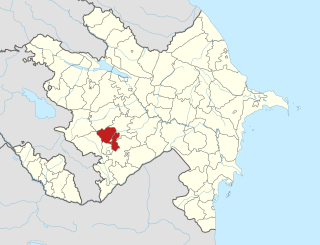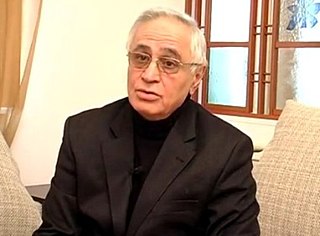
Nagorno-Karabakh is a region in Azerbaijan, covering the southeastern stretch of the Lesser Caucasus mountain range. Part of the greater region of Karabakh, it spans the area between Lower Karabakh and Syunik. Its terrain mostly consists of mountains and forestland.

Abulfaz Gadirgulu oghlu Aliyev, better known as Abulfaz Elchibey, was an Azerbaijani politician, Azerbaijani nationalist and Soviet dissident who was the first and only democratically elected President in post-Soviet Azerbaijan. He was the leader of the Azerbaijani Popular Front and played an important role in achieving Azerbaijan's independence from the Soviet Union.

Khojaly District is one of the 66 districts of Azerbaijan. It is located in the west of the country in the Karabakh Economic Region. The district borders the districts of Kalbajar, Lachin, Shusha, Agdam and Khojavend. Its capital and largest city is Khojaly. As of 2020, the district had a nominal population of 28,800.

The First Nagorno-Karabakh War was an ethnic and territorial conflict that took place from February 1988 to May 1994, in the enclave of Nagorno-Karabakh in southwestern Azerbaijan, between the majority ethnic Armenians of Nagorno-Karabakh backed by Armenia, and the Republic of Azerbaijan with support from Turkey. As the war progressed, Armenia and Azerbaijan, both former Soviet republics, entangled themselves in protracted, undeclared mountain warfare in the mountainous heights of Karabakh as Azerbaijan attempted to curb the secessionist movement in Nagorno-Karabakh.

The Battle of Shusha was the first significant military victory by Armenian forces during the First Nagorno-Karabakh War. The battle took place in the strategically important mountain town of Shusha on the evening of 8 May 1992, and fighting swiftly concluded the next day after Armenian forces captured it and drove out the defending Azerbaijanis. Armenian military commanders based in Nagorno-Karabakh's capital of Stepanakert had been contemplating capturing the town after Azerbaijani shelling of Stepanakert from Shusha for half a year had led to hundreds of Armenian civilian casualties and mass destruction in Stepanakert.
The Battle of Kalbajar took place in March and April 1993, during the First Nagorno-Karabakh War. It resulted in the capture of the Kalbajar District of Azerbaijan by Armenian military forces.

Lachin is a town in Azerbaijan and the administrative centre of the Lachin District. It is located within the strategic Lachin corridor, which linked the region of Nagorno-Karabakh with Armenia.
Surat Davud oghlu Huseynov was an Azerbaijani military officer and politician who served as Prime Minister after ousting Azerbaijan President Abulfaz Elchibey in the 1993 Azerbaijan military coup.

Rahim Hasan oghlu Gaziyev was Azerbaijani Defense Minister in 1992–1993, in the turmoil of the First Nagorno-Karabakh War, and later a political prisoner.

Lachin District is one of the 66 districts of Azerbaijan. It is located in the west of the country, belonging to the East Zangezur Economic Region. The district borders the districts of Kalbajar, Khojaly, Shusha, Khojavend, Qubadli, and the Syunik Province of Armenia. Its capital and largest city is Lachin. As of 2020, the district had a nominal population of 78,600.

The Lachin corridor was a mountain road in Azerbaijan that linked Armenia and Nagorno-Karabakh.
Operation Goranboy was a large-scale military offensive by Azerbaijan in the summer of 1992. Its aims were to take complete control of the entire territory of Nagorno-Karabakh and put a decisive end to the secessionist Nagorno-Karabakh Republic (NKR). This offensive is regarded as a successful breakthrough by the Azerbaijani Army and marked the peak of Azerbaijani success throughout the entire six years of the First Nagorno-Karabakh War.

The 1993 Azeri coup d'état, also known as the Ganja Uprising, was a military coup led by Azerbaijani military commander Surat Huseynov. On June 4, 1993, Huseynov's forces lead a march from the city of Ganja to the Azerbaijani capital of Baku in order to overthrow President Abulfaz Elchibey who was elected in independent Azerbaijan's first free election in 1992.
The Lachin offensive was a military operation launched by Azerbaijan against the unrecognized Republic of Artsakh and their Armenian allies along the Armenia–Azerbaijan border during the Second Nagorno-Karabakh War, with the suspected goal of taking control of the Lachin corridor. The offensive began in mid-October, when the Azerbaijani forces advanced into Qubadlı and Laçın Districts after capturing Zəngilan. On 25 October, the Azerbaijani forces seized control of the city of Qubadlı.

The Battle of Shusha was the final and decisive battle of the Second Nagorno-Karabakh War, fought between the armed forces of Azerbaijan and the self-proclaimed Republic of Artsakh, militarily supported by Armenia, over the control of the city of Shusha. The battle is considered one of the bloodiest battles of the war.

The Victory Day is a public holiday in Azerbaijan that is celebrated on 8 November, in commemoration of Azerbaijani victory in the Second Nagorno-Karabakh War. Established by the decree of the President of Azerbaijan from 2 December 2020, the holiday is celebrated on the day of the recapture of Shusha. It is a non-working holiday.

The Memorial Day in Azerbaijan is a public holiday in Azerbaijan for honoring and mourning the military personnel who have died while serving in the Azerbaijani Armed Forces during the 2020 Nagorno-Karabakh war, officially labelled as The Patriotic War. Established by the decree of the President of Azerbaijan, dated 2 December 2020, the holiday is held on 27 September, the day when the war began.

In the aftermath of the Second Nagorno-Karabakh War, peacekeeping operations were initiated by Russia in the Nagorno-Karabakh region to monitor the ceasefire between the Armenian and Azerbaijani forces. Separate from the Russian operation, Turkey also has personnel working in a joint Russian–Turkish monitoring centre.

Operation Kalbajar was a military offensive launched by the Azerbaijani Armed Forces in late 1993 against the forces of the Armenian Army and the self-proclaimed Nagorno-Karabakh Republic to recapture the district of Kalbajar in the final stage of the First Nagorno-Karabakh War.
This is a list of individuals and events related to Azerbaijan in 2023.














